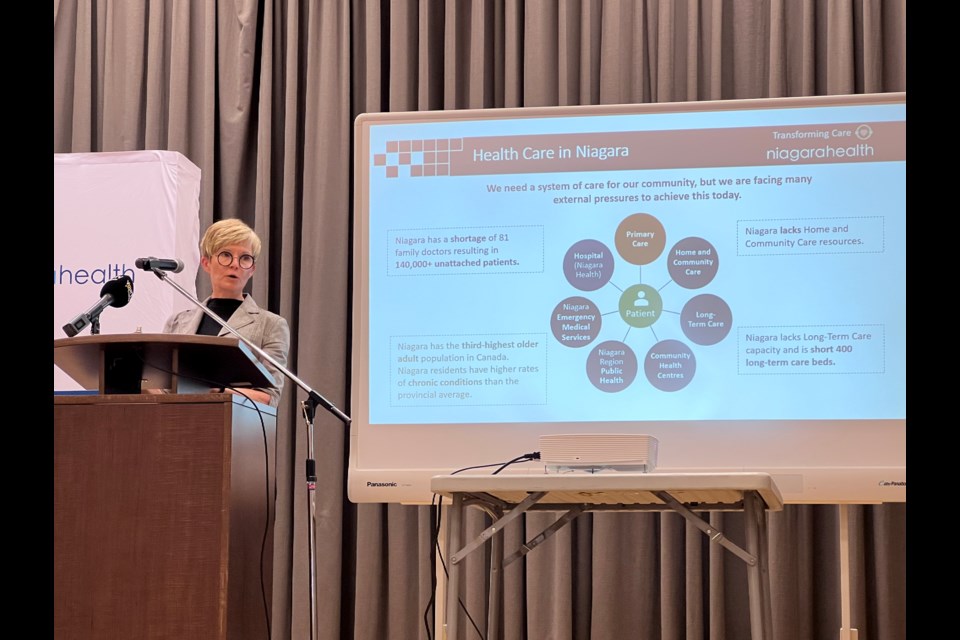Niagara-on-the-Lake residents expressed their concerns about the future of the town’s health care on Monday at the last of a series of community engagement opportunities with Niagara Health officials taking place around the Region.
At the session, which was rescheduled from an earlier date, Niagara Health’s president and CEO Lynn Guerriero outlined the challenges leading up to the decision to create a three-hospital system. These include an aging population and the complex care this requires, and the shortages of personnel across all areas of the hospital, even though 3,390 positions have been filled since April 2023.
It was explained that the current Welland, Niagara Falls and Port Colborne hospitals have outdated infrastructures and limited physical capacity. The three-site plan (St. Catharines, the new Niagara Falls site and Welland) will create more connected care opportunities and evolve antiquated systems, such as moving from fax to digital referrals.
By 2028, explained Heather Paterson, executive vice-president of clinical operations, the three-site hospital plan will offer “seamless hospital care across Niagara.”
The St.Catharines Hospital was completed in 2013. Ground broke this summer at the South Niagara Hospital, and it is expected to open in 2028. Niagara Health is awaiting a capital planning grant from the Ministry of Health before embarking on changes at the Welland Hospital, which include a “centre of excellence” for eye care.
When the floor was opened for questions from attendees, NOTL residents were not afraid to express their concerns.
Coun. Sandra O’Connor noted that the population of NOTL in the next 25 years will almost double and that the community is aging. Guerriero explained that the South Niagara site will have “a very special focus on geriatric populations,” a centre of excellence for wellness and aging.
“Years from now, it may not be enough, but we know in the sort of medium term, we do have growth within the plan,” said Guerriero.
Paterson noted that the plan includes opportunities for residents to access help outside of the hospital for complex problems due to aging. She added that a community comprehensive health team would include, among other professionals, a nurse practitioner, dietician, and occupational therapist.
Guerriero added that the way healthcare is delivered has to evolve. For example, there are some hospital procedures that could occur in the community or at home, such as some preoperative and postoperative care.
Cindy Grant asked for concrete examples of how Niagara Health will integrate with the Niagara North Family Health Team, which provides health services to over 10,000 patients in NOTL, Virgil, Queenston and St Davids. She was told that Niagara Health will have a partnership with primary care physicians, giving them expedited access to a nurse navigator who can connect the care teams with the goal of not having to utilize the emergency department.
Dr. Larry Yap, who just recently moved from Maryland to retire in NOTL, is concerned about the continuity of access to specialty care, such as cardiology and ophthalmology services. Paterson explained that Niagara Health has a partnership with Hamilton Health for cardiac care, if necessary.
“We can provide every service,” Guerriero added.
When Heidi Brown noted that imaging is not available in our local community, Guerriero talked about independent health facilities. “The current government is hoping to expand community-based health centres, including those diagnostic facilities. We have been pushing, you would not believe how hard, for the government to make sure that one or more licences come to Niagara, specifically in Port Colborne and Fort Erie.”
Peter Warrack expressed concern that the community will have to help fund the cost of hospital equipment, but Guerriero assured him that even though hospitals are expected to come up with 100 percent of the cost of equipment, “the foundation is doing a tremendous job of fundraising.”
Lord Mayor Gary Zalepa wanted a better understanding of EMS response times. Guerriero noted that an average trip to any of the current sites takes between 27 to 29 minutes, which falls under the standard time limit of 30 minutes. EMS, with lights and sirens, would be able to decrease those times.
A question submitted electronically asked how people will know which hospital to go to. Each of the sites will have a different area of expertise but “a patient will be able to go to any Niagara Health site even if it doesn't offer the services you need,” because the three sites will work together to get the care you deserve. 'There are no wrong doors,” said Paterson.
For further details on Niagara Health's three-site plan, click here.
